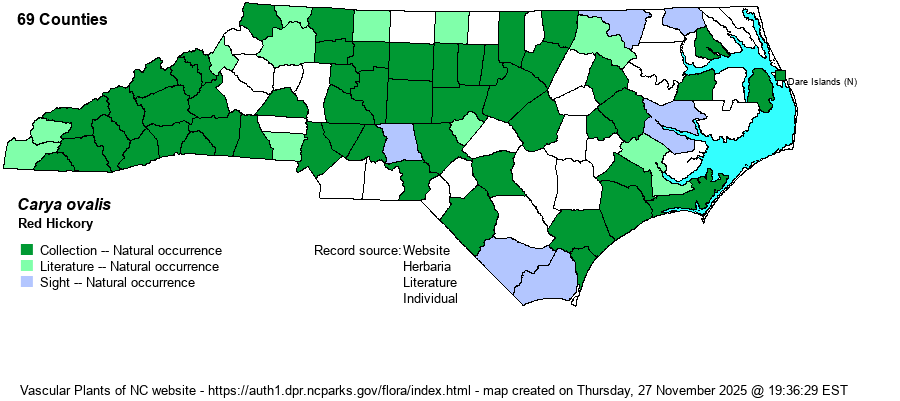| Section 6 » Order Juglandales » Family Juglandaceae |
Show/Hide Synonym
| taxonName | relationship | relatedTaxonName | relatedTaxonRefText | relComments |
|---|
|
|
|
|
|
| Carya ovalis | > | Carya ovalis var. obcordata | Fernald (1950) | | | Carya ovalis | > | Carya ovalis var. obcordata | Gleason (1952) | | | Carya ovalis | > | Carya ovalis var. obcordata | | | | Carya ovalis | > | Carya ovalis var. obovalis | Fernald (1950) | | | Carya ovalis | > | Carya ovalis var. obovalis | Gleason (1952) | | | Carya ovalis | > | Carya ovalis var. obovalis | | | | Carya ovalis | > | Carya ovalis var. odorata | Fernald (1950) | | | Carya ovalis | > | Carya ovalis var. odorata | Gleason (1952) | | | Carya ovalis | > | Carya ovalis var. odorata | | | | Carya ovalis | < | Carya glabra | Flora of North America (1993b, 1997, 2000, 2002a, 2002b, 2003a, 2004b, 2005, 2006a, 2006b, 2006c, 2007a, 2009, 2010) | | | Carya ovalis | < | Carya glabra | | | | Carya ovalis | < | Carya glabra | | | | Carya ovalis | < | Carya glabra | | | | Carya ovalis | = | Hicoria microcarpa | Small (1933, 1938) | | | Carya ovalis | = | Carya glabra var. odorata | Wofford (1989) | | | Source: Weakley's Flora |
|
| Author | (Wangenheim) Sargent | |
| Distribution | Essentially statewide, but as this is a difficult species to identify for many biologists, it has been much less collected for documentation than have Pignut (C. glabra) and Mockernut (C. tomentosa) hickories. Perhaps occurs in nearly all 100 counties, but possibly absent in some far eastern counties and the Sandhills proper. Sizable "holes" in the range elsewhere, such as the northwestern Piedmont and south-central Coastal Plain, are probably not real.
A wide range in the Eastern part of the continent, from ME to IA, and south to GA and MS.
| |
| Abundance | This is not as numerous in the state as Pignut and Mockernut hickories. It is generally uncommon to fairly common west of the Coastal Plain; but it is best called rare to occasional in the Coastal Plain, and very rare to absent in far eastern counties; probably most numerous in the southeastern counties near the coast. Statewide, likely most numerous in the Mountains; it is considered as common in the mountains and inner Piedmont of VA in Flora of Virginia (2012). | |
| Habitat | This species is found mainly in the same habitats as are Pignut and Mockernut hickories – in upland oak-hickory forests, mostly dry to mesic soil conditions; however, there is some indication that it favors somewhat more circumneutral soils than do those widespread species. Flora of Virginia says it is more often found in high pH soils, which may explain why it is less numerous than those species, as high pH soils are not common in large areas of the state. Some of the hardwood forests in the southeastern counties are underlain by marl and thus have high pH soil; this likely explains why there are records from Jones and Carteret counties southwest to the SC border. | |
| Phenology | Flowers in April and May, and fruits in October. | |
| Identification | This is a medium to large deciduous tree, at times reaching 100 feet tall. Many of its characters are quite similar to those of the Pignut Hickory – such as slender twigs and small buds, with which it is still considered just a variety by many references. However, Red Hickory has trunk bark that is somewhat more deeply furrowed (vertically) and can at times show somewhat shaggy bark, a bit like that of Shagbark Hickory (C. ovata). Pignut Hickory has smoother bark that can also be ridged, but not usually deeply furrowed and never loose and shaggy. Also, Red Hickory has 7 leaflets on average, though often also shows 5 leaflets on some leaves; Pignut has mostly 5 leaflets per leaf. Most importantly, Red Hickory usually – but not always – has purplish to pale red petioles, as opposed to usually green petioles on Pignut. (You never notice petiole color on other hickories.) There are also differences in splitting of the husk on the fruit. Any time you run across a hickory with reddish petioles, you should have this species. Also, when you find a hickory in uplands with 7 leaflets, and slender stems with small end buds, but the petioles are not reddish, you may have this species, but look at the undersides of the leaves for silvery scales, which is a characteristic of Sand Hickory (C. pallida). | |
| Taxonomic Comments | There is a major dichotomy of opinion on this taxon. Many references, even as far back as RAB (1968), as well as Weakley (2018), list it as a good species. Others have it as a variety of Pignut Hickory, generally as C. glabra var. odorata, but other names include var. ovalis and var. obcordata. A rare few have it – disturbingly -- completely subsumed within Carya glabra.
| |
| Other Common Name(s) | It is often known as Sweet Pignut Hickory | |
| State Rank | S4 | |
| Global Rank | G5 | |
| State Status | | |
| US Status | | |
| USACE-agcp | FACU link |
| USACE-emp | FACU link |

